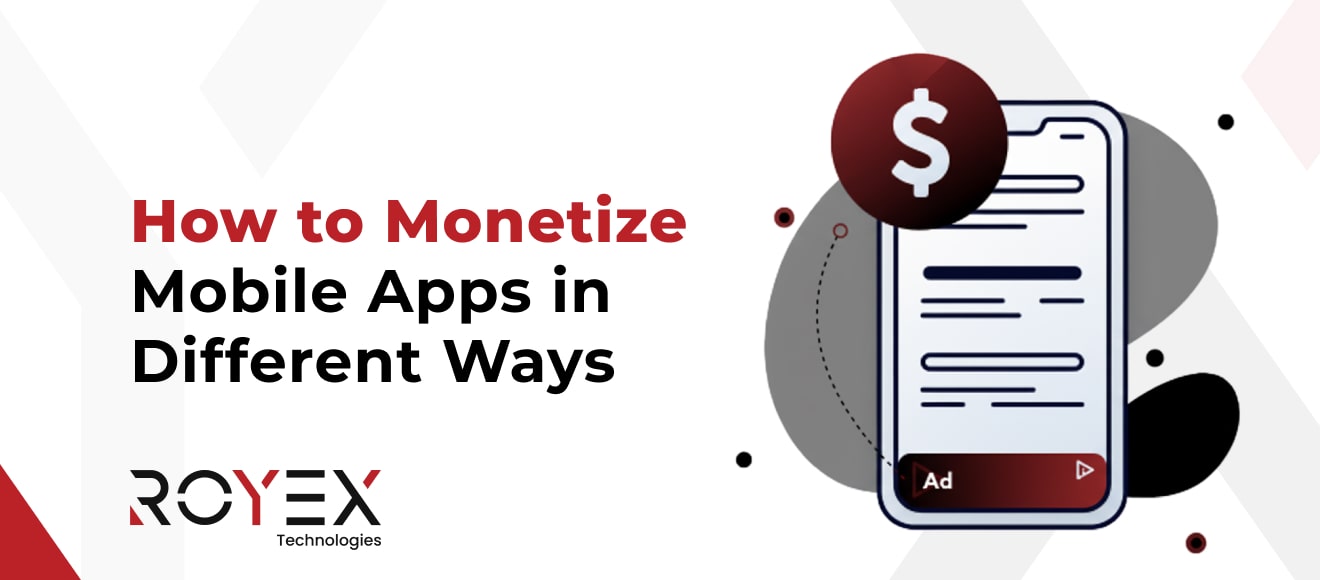
How to Monetize Mobile Apps in Different Ways
Monetization is one of the central concerns for anyone building a mobile app. You might have a great idea, excellent design, great UX, and technical stability—but if you can’t turn user engagement into revenue (or some business benefit), the app may not be sustainable.
Note: Based on common questions asked by our customers to us before developing mobile apps, we have listed most of the questions and answers in detail of each question. This is a series of articles about “Mobile App Journey: Things You Must Know”.
In this article we will explore:
- The different monetization methods available for mobile apps
- Which methods are more suitable for which types of apps
- Pros & cons of each method
- Some recent statistics showing what works well in today’s market
- Best practices & combined strategies
- Finally, why working with a strong development partner like Royex can matter for monetization success.
Overview: Why Monetization Strategy Matters
- The app marketplace is huge and growing. Different app categories, platforms, geographies have different paying behaviors.
- Your choice of monetization affects user acquisition, user retention, user experience, technology choices, regulatory / platform fees (App Store, Google Play), and even how you market the app.
- Monetization should ideally be considered early in the design / product planning phase—not something tacked on at the end.
Key Statistics (2023-2025)
Here are a few relevant contemporary stats to help ground which monetization strategies are working well:
- Global app revenue in 2024 was over US$613 billion. (TMS)
- The mobile app market is projected to surpass US$626 billion by 2030. (Adjust)
- Games apps dominate revenue share: for example, in 2020, about 71% of total apps revenue was generated by games. (Tipalti)
- Free apps make up the vast majority of app downloads; paid apps are a small percentage. In 2020, free downloads were ~96.9% on Google Play and ~93.4% on Apple App Store. Paid app downloads were ~3.1% (Android) and ~6.6% (iOS). (Tipalti)
- In-app purchases and subscriptions are among the monetization models bringing in the most revenue. (Tipalti)
- Users generally tolerate ads if they are not intrusive; about 71% of users are willing to view ads in exchange for free access to an app. (venatus.com)
These statistics suggest:
- Monetization models that support free entry (with optional payment later) tend to reach a much larger audience.
- Games have an advantage with in-app purchases and ads.
- Subscription models are gaining importance.
- Ads remain a strong revenue channel if done well.
Different Monetization Methods: Detailed Breakdown
Here are the main ways to monetize a mobile app. For each, I’ll explain what it is, typical app categories that use it well, pros & cons, and considerations.
1. Paid App (One-Time Purchase / Upfront Fee)
What it is:
Users pay once (at download) to purchase the app; after that, no further payments are required (unless for updates / versions etc.).
Best suited for:
- Utility apps with clear, high-value function (e.g. productivity tools, niche calculators, professional tools)
- Apps where the core functionality is well defined and doesn't require frequent content updates
- Markets / regions where users are accustomed to paying up front and trust paid apps
Pros:
- Simple model: users pay once; revenue is predictable per download.
- No continual pressure to upsell or deliver subscription content.
- Less need for heavy backend content updates (if functionality is fixed).
- Lower dependence on ad-networks or ad quality.
Cons:
- Barrier to entry: users may hesitate to pay before trying. This can reduce download volumes.
- Updating / maintaining the app still costs money; unless you release major new versions (possibly paid updates), revenue may drop over time.
- Competitive disadvantage vs free / freemium apps.
- Platform fees (App Store, Google Play) reduce your take (often ~30% or more, depending).
2. Freemium Model
What it is:
App is free to download and use with basic features; more advanced features, content, or enhancements are locked behind paywalls or in-app purchases / subscription.
Best suited for:
- Apps with both basic & advanced features: e.g. photo editing, productivity, fitness / health, education.
- Apps that want to attract large user base quickly, then convert a portion of users into paying customers.
- Apps targeting markets with lower ability (or willingness) to pay up front; free is compelling.
Pros:
- Low barrier to install → high user acquisition.
- Opportunity to monetize heavy users or those who derive high value.
- Flexible: you can offer features, content, services as paid upgrades.
- Can combine with other monetization methods (ads, subscriptions, etc.).
Cons:
- Only a small percentage of users typically convert to paid tier. Need strong value proposition in premium features.
- Need continuous work to maintain / build premium content/features to keep users interested.
- Risk of alienating free users if premium features feel too restrictive.
- Also platform fees on in-app purchases.
3. Subscriptions
What it is:
Users pay a recurring fee (monthly, yearly, sometimes weekly) to access features, content, or services.
Best suited for:
- Content-heavy apps (news, magazines, streaming audio/video, health & fitness, education)
- Apps that provide value over time, needing continuous content or services
- Apps with loyal usage / recurring value
Pros:
- Predictable, recurring revenue stream.
- Encourages continuous engagement and retention; helps with LTV (lifetime value) of user.
- Easier to forecast revenue and plan updates / improvements accordingly.
Cons:
- User resistance: some users dislike subscriptions.
- Need to continuously deliver value (content / improvements) or risk churn.
- Managing subscription pricing, renewing periods, trials, cancellations adds complexity.
- Platform commission fees.
4. In-App Purchases (IAP) / Microtransactions
What it is:
Users make purchases inside the app: virtual goods, extra levels, unlocking features, cosmetic items, consumables, etc.
Best suited for:
- Games are the most obvious example.
- Social apps, virtual community apps with cosmetic items, virtual gifts.
- Any app where incremental enhancements or optional features make sense.
Pros:
- Potential for very high ARPU (Average Revenue Per User) among engaged users.
- If done right, users who enjoy the app may spend without hesitation.
- Flexibility: microtransactions can be small or large depending on item; can offer multiple tiers.
Cons:
- Very uneven revenue: many users don’t spend anything; a small fraction (whales) generate a disproportionate share of revenue.
- Need careful balancing to avoid “pay-to-win” or greed-perception issues (especially in games).
- Platform policies / fees apply.
5. Advertising
What it is:
Showing ads in the app: banners, interstitials, rewarded video, native ads, etc. You earn revenue from ad impressions, clicks, or other engagement metrics.
Best suited for:
- Apps with large active user bases and high engagement but where users may not pay much.
- Free apps or freemium apps where monetization through purchase is limited.
- Games (especially casual), utility / tools, entertainment apps.
Pros:
- Enables the app to be free, maximizing install volumes.
- Can monetize even passive users (who don’t purchase).
- Rewarded video ads can be popular: users choose to view in exchange for some in-app benefit.
- Many ad networks / tools exist; relatively mature ecosystem.
Cons:
- Ad fatigue / user irritation: badly placed or too frequent ads can reduce retention.
- Revenues from ads vary a lot (geography, ad type, fill rate).
- Need moderation / filtering (low quality ads or bad user experiences can harm brand).
- Platform policies and third-party SDKs can add overhead / privacy concerns.
6. Affiliate Marketing / Partnerships / Sponsorships
What it is:
Earn commission by recommending other products / services; or having brands sponsor content inside the app.
Best suited for:
- Apps with relevant content or audience (e.g. review apps, comparisons, niche content)
- Media / content platforms, blogs inside apps, shopping / deals apps
Pros:
- Potentially low overhead: you don’t create the product; you just link / refer.
- If the audience matches well, commissions can add up.
- Adds diversity to your revenue streams (not just in-app purchases or ads).
Cons:
- Requires good audience trust; if recommendations are irrelevant, users may lose faith.
- Revenue depends on affiliate partner program terms, conversion rates.
- May require additional legal / disclosure obligations.
7. Sponsorships & Branded Content
What it is:
Your app features content or branding from sponsors. Could be in the form of branded challenges, content, or integrated campaigns.
Best suited for:
- Entertainment / media apps, apps with content or social / community focus.
- Apps with high-visibility / wide user base.
Pros:
- Can generate significant upfront or recurring revenue.
- Sometimes more stable / predictable than ads because you negotiate direct deals.
- Enhances brand credibility if aligned with relevant sponsors.
Cons:
- Finding sponsors whose brand aligns with your app’s audience can be difficult.
- May limit creative / UI freedom (you may need to include sponsor requirements).
- If sponsorship feels forced or irrelevant, users may dislike it.
8. Selling Physical Goods or Services via the App
What it is:
App is a storefront, or includes a marketplace or a service that is material / physical (or services rendered offline). Think e-commerce apps, delivery apps, booking-services, etc.
Best suited for:
- Retail / e-commerce apps, physical product sales
- Apps that facilitate real-world services (cleaning, food delivery, ride-hailing)
- Local businesses that want mobile presence
Pros:
- Revenue is not tied to digital content or in-app purchases. Real-world value.
- High potential, especially for niche or local markets.
- Can often leverage existing supply chains / inventory.
Cons:
- Logistics, shipping, inventory, service fulfillment all add cost and complexity.
- Margins may be lower due to costs (shipping, returns, staffing).
- Regulatory / tax obligations can be more involved.
9. Data Monetization / Selling Insights
What it is:
Collect anonymized, aggregated user data (usage patterns, preferences, behavior) and sell insights (or provide analytics as a service), or share for research. Must adhere strictly to privacy laws (GDPR, CCPA, etc.).
Best suited for:
- Apps with large user bases and interesting usage data (consumer behavior, health & fitness, location, etc.)
- Apps that can collect data ethically, with transparency and user consent
Pros:
- Potential to generate revenue without charging users or showing them ads.
- Can be very lucrative if data is unique and valuable.
Cons:
- Privacy, legal, ethical challenges.
- Users may distrust apps that collect too much data.
- Platform / regulatory restrictions; also risk of data breach / security issues.
10. Other / Emerging Models
- Freemium + Advertising Hybrid: Free core, ads for all, but remove ads for a price or offer premium version.
- Rewarded Actions: Users get rewards (in-app content, coins, etc.) for watching video ads or performing offers.
- Paywalls for Content: For certain content-heavy sections (e.g. premium articles, reports, courses).
- Subscription + IAP Combination: Base subscription + premium extras via IAP.
- Licensing (for enterprise / B2B apps): Sell app license or white-label version to businesses.
Matching Methods to App Types: What Works Best Where
Below is a table or guide mapping types of apps to monetization strategies that often work well.
Pros & Cons Summary (Across Models)
Here’s a comparative overview of the advantages and trade-offs among major monetization models.
Multi-Method / Hybrid Monetization & Best Practices
Often the most successful apps don’t rely on only one monetization method but combine several in ways that make sense for user experience and growth.
Best Practices
- Start with Free / Low Barrier Entry
Let users try with minimal friction; then upsell or monetize via premium, subscription, or ads. - Offer Value First
Whether free or premium, make sure core functionality or content is meaningful. If users see value, they are more likely to pay or accept ads. - Segment Your Users
Different users behave differently. Heavy users might be willing to pay; occasional users may be fine with ad revenue. Tailor your approach. - Optimize for Retention & Engagement
Lifetime value (LTV) depends heavily on retention. More engaged users are more likely to convert, subscribe, make in-app purchases, etc. - Test Pricing & Offers
A/B testing for pricing, subscription durations, premium feature sets, ad frequency, etc. See what yields best conversion / revenue without harming UX. - Watch Platform & Regulatory Policies
App Store and Google Play have rules about in-app purchases, subscriptions, refunds, payments. Also data/privacy laws like GDPR, CCPA etc. - Balance Revenue & UX
Aggressive monetization can drive revenue in short term but damage retention / reviews long term. - Monitor Metrics Closely
Important metrics include ARPU, ARPDAU (average revenue per daily active user), LTV, retention, churn, cost of acquisition (CAC), conversion rate (from free to paid), etc.
Recent Trends & What the Market Prefers
Some trends in app monetization that are growing / worth noting (as of 2023-2025):
- Subscription revenues are growing faster than some traditional models. Apps offering ongoing value (content, services) are benefiting. (Tipalti)
- Advertising spend in mobile apps remains large and increasing. The quality of ad formats (rewarded video, interstitials, native) is improving. (Adjust)
- Hybrid models (freemium + ads + subscription) are becoming more common. (Paddle)
- Increase in regulatory attention to privacy & data monetization; users are more aware / sensitive. Apps need transparent privacy policies and secure handling.
- Emerging interest in non-traditional models: e.g. monetizing via web (outside the App Store), paywalls, greater reliance on community / creator economy. (Paddle)
How to Choose the Right Monetization Method for Your App
Here are steps you ought to take when selecting your monetization strategy:
- Define Your App’s Value Proposition
What problems does it solve, what features are core vs optional, how frequently will users use it? - Understand Your Target Users & Market
Will they pay up front? Are they used to subscription models? What is the competition doing? Geographic region matters (willingness to pay, ad rates, etc.). - Estimate Key Metrics
Project potential user base size, retention, conversion rates, cost of acquiring users. Use benchmarks by category / geography where possible. - Consider Development & Maintenance Costs
Monetization methods like subscription, premium content, IAP require ongoing content / infrastructure; ads require integrating ad SDKs, ensuring ad quality, etc. - Plan for Flexibility / Pivoting
It’s rare that your first monetization model is perfect. Plan to adjust, add hybrid models, test new revenue streams. - Ensure Compliance & Good UX from the Start
Avoid surprises: legal issues, platform rejections, privacy concerns, bad user reviews.
Putting It All Together: Example Scenarios
Here are some hypothetical or real-world examples showing how different methods can be combined.
- A fitness app might offer a free version with basic workouts, include ads in free version, then a subscription for premium workouts, diet plans, tracking, etc.
- A casual game might be free to download, include in-app purchases (extra lives, skins), rewarded video ads for bonus items, optionally a “premium version” to remove ads.
- A news app may allow free reading of some articles, ads for free readers, subscription for full access, plus affiliate partnerships for books or products mentioned in content.
- A photo editing app—free basic filters, extra filter packs via purchase, monthly subscription for full features or cloud storage, maybe affiliate partnerships for printing/photo printing services.
Prospective Revenue Estimates & Challenges
- Many apps never make significant revenue. One article suggests that only ~0.5% of consumer apps are “successful” in earning major revenue. (AdPushup)
- Even for an app with 1,000 downloads, revenue might be very low, depending on the monetization method and conversion. For example, ads & in-app purchases yield differently by region. (AdPushup)
- ARPU (average revenue per user) tends to be much higher in iOS markets vs Android; in developed markets vs emerging ones. So geographic targeting & localization can matter a lot.
Why Royex Is a Strong Choice for Mobile App Development & Monetization Success
While many companies can build apps, certain partners bring advantages that significantly improve the chances of successful monetization. Here’s why Royex Technologies stands out (assuming from what customers often learn / perceive):
- Experience & Track Record
Royex has developed many mobile apps across different categories (games, utilities, enterprise, e-commerce, etc.), giving them insight into what monetization models tend to work in each category. - Strategic Planning & Monetization from Day One
Royex tends to incorporate monetization strategy early in the planning stage, not as an afterthought. They help clients decide models, pricing, premium features, and hybrid models that suit the audience and market. - Strong Technical & UX Skills
Good monetization depends heavily on user experience: seamless in-app purchases, smooth UI, well-placed ads, efficient code, minimal bugs. Royex’s developers are reputed to deliver reliable apps, which helps reduce churn and increase user satisfaction. - Localization & Market Understanding
Understanding user behavior in different geographies (willingness to pay, ad revenue per user, cultural preferences) is important. Royex, being based in a region bridging many global markets, often has good insight into emerging markets as well as developed ones. - Maintenance & Support
Revenue isn’t just from launch: delivery of updates, premium content, subscription renewals, keeping users engaged—all require maintenance. A company that supports post-launch well helps maintain monetization. - Transparency & Ethical Practices
Ensuring privacy compliance, adherence to platform policies (App Store, Google Play), security of in-app purchases, etc. Royex’s reputation is helped by ethical practices, which builds user trust, which in turn supports monetization.
Summary & Recommendations
- There is no “one size fits all” monetization method. The choice depends on app type, target audience, geography, competition, and your capacity to build / maintain premium content or features.
- Hybrid strategies often perform better: combining free entry + ads + optional premium or subscription yields more options and flexibility.
- Test early, measure key metrics (ARPU, LTV, retention, conversion), iterate, and be prepared to adjust.
- Don’t sacrifice user experience in pursuit of revenue—long-term success often depends on satisfied users, good reviews, retention.
- Always align monetization with legal, privacy, and platform policy constraints.
Which Method(s) Might Be Best for You?
If you are considering building an app, here are some guiding heuristics:
- If your app is simple, niche, and solves a distinct problem → Paid app or freemium with optional extras might work.
- If your app content is continuously updated (e.g. news, content, fitness, education) → a subscription model or freemium + subscription makes sense.
- If your app wants maximum reach or network effects, or target users who are unlikely to pay upfront → free + ads (especially rewarded ads) + optional premium is safer.
- If your app has a built-in community or social / virtual economy → in-app purchases / virtual goods / cosmetic items can be powerful.
Conclusion
Monetizing a mobile app is about more than just picking a way to make money. It’s about balancing user experience, market demand, competition, legal / platform requirements, and sustainability.
Used wisely, models like subscription, in-app purchases, advertisements, partnerships, and hybrid combinations can make an app financially viable, satisfying for users, and scalable. But misused, they can push users away, invite negative reviews, or even cause legal/regulatory trouble.
If you leverage experience, test carefully, iterate based on real user data, and plan monetization strategies from the start, your chances of success rise significantly.
And if you partner with a mobile app development company in Dubai like Royex that understands both technology and business strategy, you’ll likely avoid many common pitfalls and increase your return on investment.
Sources
- Tipalti — “A Complete Guide to App Monetization for 2025” (Tipalti)
- Adjust — “Mobile app monetization trends: How apps make money” (Adjust)
- App Monetization Statistics: Data-driven Insights for Growth (AdPushup) (AdPushup)
- Paddle — Mobile App Monetization Guide (Paddle)
- Gilion — “App Monetization: Maximize Revenue in 2025” (gilion.com)
- Venatus — “10 Eye-Opening App Monetization Stats” (venatus.com)
- Amity / Social.plus — “20 App Monetization Stats You Should Know” (social.plus)





